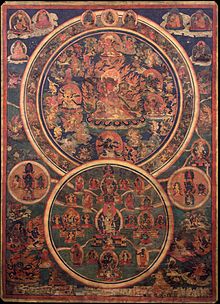Antarābhava
Antarābhava (huān-gú: अन्तरभाव (antarābhava); tâi-gú: tiong-iú, tiong-im, tiong-ùn, tiong-im sin, tiong-iú sin; hàn-gú: 中有, 中陰, 中蘊, 中有身, 中陰身; tsōng-gú: བར་དོ་ (bardo)), koh kiò-tsò tiong-im, tiong-un, tiong-iú-sin, tiong-im-sin),[1] sī Hu̍t-kàu ê su̍t-gú ì-sù sī teh piáu-sī sèñ-miā teh sí-bông tsi hiō, kàu ē-tsi̍t-kî sèñ-miā khai-sí tsi-tsîng tiong-kan ê tshûn-tsāi tsōng-thài. Antarābhava sī sèñ-miā lûn-huê ê tsi̍t pōo-hūn, luī-sū it-puañ sóo-kóng ê lîng-hûn, kuí-hûn, hûn-phik, guân-sîn, sè-bî-sin tíng-tíng ê sueh-huat; m̄-kù Hu̍t-kàu tuì antarābhava ū ka-kī ê lí-lūn kái-sueh.

Teh Hu̍t-kàu ê lí-lūn lāi-té, bô kāng-khuán pōo-phài tuì antarābhava ê khài-liām iú-sóo tsing-lūn. Sarvastivada tsi-tshî antarābhava ha̍k-suat, m̄-kù Mahāsāṃghika kah Vibhajyavāda tō bô tsi-tshî antarābhava ê ha̍k-suat. Sthavira nikāya Hu̍t-kàu hiú-tīng antarābhava lí-lūn, m̄-koh hàn-thuân hu̍t-kàu kah tsōng-thuân hu̍t-kàu tō-lóng phóo-phèn tsiap-siū antarābhava ê siūñ-huat.
Tsù-kái
siu-kái- ↑ Bareau, André (1979). "Chuu". Chū Lévi, Sylvain; Takakusu, Junjiro; Gernet, Jacques; May, Jacques; Durt, Hubert. Dictionnaire encyclopédique du bouddhisme d'après les sources chinoises et japonaises. Hôbôgirin. Fasc. 5. Editions Maisonneuve. pp. 558–563. ISBN 9068316052. OCLC 928777936. (Eng-gí)
Ên-sin ua̍t-to̍k
siu-kái- American Book of the Dead. 1987. E.J. Gold. Nevada City: IDHHB. (Eng-gí)
- Bardo Teachings: The Way of Death and Rebirth. 1987. By Venerable Lama Lodo. Ithaca, NY: Snow Lion Publications ISBN 0937938602 (Eng-gí)
- The Bardo Thodol: A Golden Opportunity. 2008. Mark Griffin. Los Angeles: HardLight Publishing. (Eng-gí)
- Death, Intermediate State, and Rebirth. 1981. Lati Rinpoche. Snow Lion Publications. (Eng-gí)
- The Hidden History of the Tibetan Book of the Dead. 2003. Bryan J. Cuevas. New York: Oxford University Press. (Eng-gí)
- Mirror of Mindfulness: The Cycle of the Four Bardos, Tsele Natsok Rangdrol, translated by Erik Pema Kunsang (Rangjung Yeshe Publications). (Eng-gí)
- Natural Liberation. 1998. Padmasambhava. The text is translated by B. Alan Wallace, with a commentary by Gyatrul Rinpoche. Somerville, Wisdom Publications. (Eng-gí)
- The Tibetan Book of the Dead: Awakening Upon Dying. 2013. by Padmasambhava (Author), Chögyal Namkhai Norbu (Commentary), Karma Lingpa (Author), Elio Guarisco (Translator). Shang Shung Publications & North Atlantic Books. (Eng-gí)
- The Tibetan Book of Living and Dying. 1993. Sogyal Rinpoche. New York: HarperCollins. (Eng-gí)
Tsham-ua̍t
siu-kái- Chho͘-pán (tshoo-pán; tē-1 pán/Editio princeps) – essentially, the first printed edition of classical or medieval works
- Tāi Ji̍t-pún tè-kok lio̍k-kun ping-khì tshing-tuañ
- Koan-pò (Kuan-pò (Ji̍t-pún tsìng-hú pò-tsuá)/官報)
- Hata Ikuhiko (秦郁彦)
- Smartfren
Guā-pōo lên-ket
siu-kái- Public domain PDF and audio versions of the Tibetan Book of the Dead (Eng-gí)
- The Eight Bardos, Khenchen Konchog Gyaltshen, Lion’s Roar magazine (Eng-gí)
- Schomberg, Koshin (n.d.), How to Grow a Lotus Blossom: Reflections (PDF), Serene Reflection Dharma Association Soto Zen preparations for dying (Eng-gí)
- A modern commentary on Karma Lingpa’s Zhi-khro teachings on the peaceful and wrathful deities (Eng-gí)
- The Psychedelic Experience: A manual based on the Tibetan Book of the Dead, 1967. By Timothy Leary, Ph.D.; Ralph Metzner, Ph.D.; & Richard Alpert, Ph.D. (later known as Ram Das) (Eng-gí)
- Tibetan Buddhism and the resolution of grief: The Bardo-Thodol for the dying and the grieving, by Robert Goss, Death Studies, Vol. 21 Issue 4 Jul/Aug.1997, Pp.377-395 (Eng-gí)
- 中阴救度密法Archived 2012-05-23 at the Wayback Machine. (Hàn-gí)
- 释如石,《西藏度亡经》略究Archived 2006-05-07 at the Wayback Machine. (Hàn-gí)
- 杜永彬,《西藏度亡经》在西方的影响 (Hàn-gí)
- 中陰與投胎,《大藏經》中陰與投胎資料Archived 2009-05-30 at the Wayback Machine. (Hàn-gí)